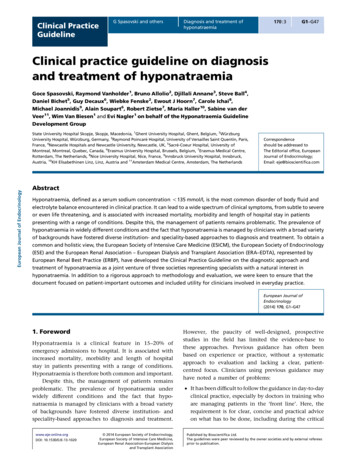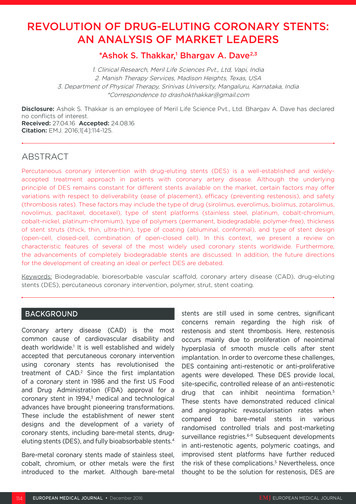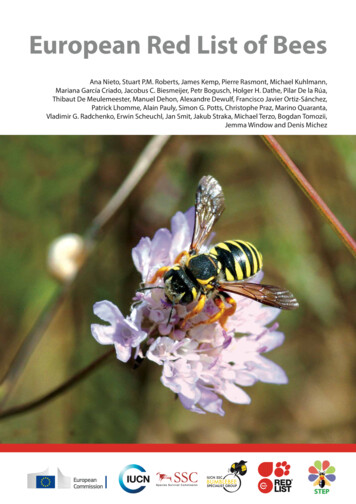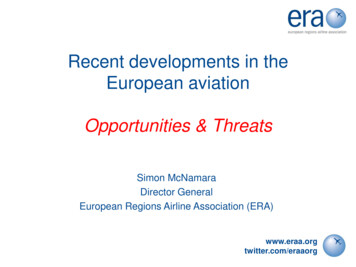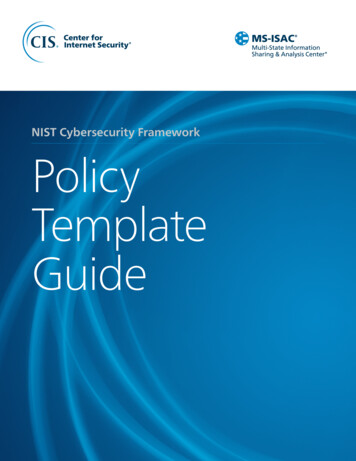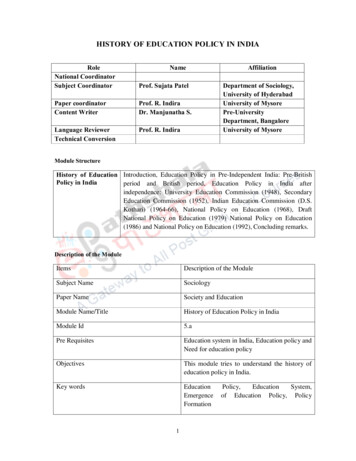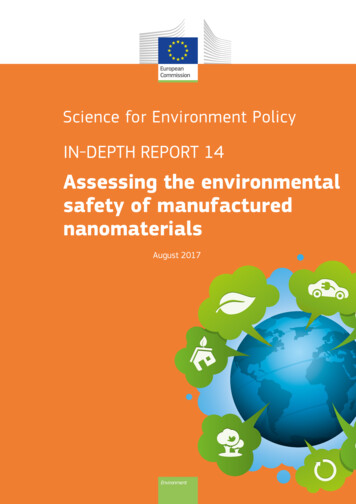
Transcription
Science for Environment PolicyIN-DEPTH REPORT 14Assessing the environmentalsafety of manufacturednanomaterialsAugust 2017Environment
2A S S E S S I N GT H EE N V I R O N M E N T A LS A F E T YScience for Environment PolicyAssessing the environmental safetyof manufactured nanomaterialsO FM A N U F A C T U R E DN A N O M A T E R I A L SThis In-depth Report is written and edited by the ScienceCommunication Unit, University of the West of England(UWE), BristolEmail: sfep.editorial@uwe.ac.ukTo cite this publication:Science for Environment Policy (2017) Assessing the environmentalsafety of manufactured nanomaterials. In-depth Report 14produced for the European Commission, DG Environment bythe Science Communication Unit, UWE, Bristol. Available cknowledgementsWe wish to thank the following for their contributions to thisreport: Fadri Gottschalk (ETSS AG, Switzerland)Final responsibility for the content and accuracy of the report,however, lies solely with the author.About Science for Environment PolicyScience for Environment Policy is a free newsand information service published by the EuropeanCommission’s Directorate-General Environment,which provides the latest environmental policyrelevant research findings.In-depth Reports are a feature of the service,introduced in 2012, which take a comprehensivelook at the latest science for key policy topics.In addition to In-depth Reports, Science forEnvironment Policy also publishes a weeklyNews Alert which is delivered by email tosubscribers and provides accessible summariesof key scientific studies.ISBN: 978-92-79-45732-6ISSN: 2363-2798DOI: 10.2779/690478The contents and views included in Science for EnvironmentPolicy are based on independent research and do not necessarilyreflect the position of the European Commission. European Union, 2017. Reproduction is authorised and encouraged, provided the source isacknowledged in the form above. Please send any resulting outputs to sfep.editorial@uwe.ac.ukfor our licyKeep up-to-dateSubscribe to Science for Environment Policy’sweekly News Alert by emailing:sfep@uwe.ac.ukOr sign up online at:http://ec.europa.eu/science-environment-policy
A S S E S S I N GT H EE N V I R O N M E N T A LS A F E T YO FM A N U F A C T U R E DN A N O M A T E R I A L SContentsExecutive Summary1. Introduction1.1 General role of policy for thenanomaterials market1.2 Role of science in policymakingfor nanomaterials1.3 Describing and definingnanomaterials1.4 Characterisation ofnanomaterials1.5 Rationale for structure of report2. State of science ofnanomaterials2.1 History2.2 Advances in applications andmanufacture2.3 Nanosafety2.4 Knowledge gaps and challenges2.5 Current research strategies onnanosafety3. Characterisation3.1 Existing methods forcharacterisation3.2 Knowledge gaps and challenges3.3 Current and future developments4. Exposure4.1 Release of manufacturednanomaterials (MNM)4.2 Emission and transportation ofMNMs4.3 Environmental exposure toMNMs4.4 Existing techniques formeasurement4.5 Knowledge gaps4.6 Current and futuredevelopments: nanomaterialsexposure under project 55033
4A S S E S S I N GT H EE N V I R O N M E N T A LS A F E T YO FM A N U F A C T U R E DContents continued5. Hazard: toxicology andecotoxicology5.1 Toxicology5.2 Ecotoxicology5.3 Nanoecotoxicology5.4 Current understanding ofnanoecotoxicology5.5 Species sensitivity distributions5.6 Knowledge Gaps5.7 Current developments:6. Risk assessment6.1 Existing risk assessmentmethodologies (Rickerby et al. 2015;Rio-Echevarria & Rickerby 2015)6.2 The MARINA risk assessmentstrategy (Bos et al. 2015)6.3 Life cycle analysis6.4 Knowledge gaps6.5 Current developments7. Current and future challengesfor the science-policyinterface7.1 Nanomaterials on the market7.2 Third-generation MNMs andbeyond7.3 Nanomaterials as part of aproduct7.4 Closing knowledge gaps7.5 Meeting the 686869697172N A N O M A T E R I A L S
A S S E S S I N GT H EE N V I R O N M E N T A LS A F E T YO FM A N U F A C T U R E DN A N O M A T E R I A L S5Executive summaryLibrary of anisotropic gold nanoparticles: Transmission Electron Microscopy (TEM) micrographs by Dr Željka Krpetić (University ofSalford Manchester), Qi Cai and Jennifer Cookman (CBNI, UCD).Engineering at the nanoscale (one million to tenthousand times smaller than a millimetre; i.e. 1to 100 nanometres) brings the promise of radicaltechnological development — clean energy, highlyeffective medicines and space travel. But technologyat this scale brings its own safety challenges. ThisIn-depth Report shows that, despite early fears,nano-sized particles are not inherently more toxicthan larger particles, however, differences betweenthem may be notable and new insights are still beingprovided by research. The effects of nanoparticleson humans and the environment are complex andvary based on particle properties as well as chemicaltoxicity. This Report brings together the latest scienceon environmental safety considerations specific tomanufactured nanoscale materials, and the possibleimplications for policy and research.
6A S S E S S I N GT H EE N V I R O N M E N T A LThe aim of this In-Depth Report is to present the mostpromising strategies and most significant challengesof nanomaterial characterisation, exposure, fate andbehaviour, ecotoxicological hazard and risk assessment.It presents examples and case studies of both thescientific developments and the knowledge gaps.Nanomaterials have many different forms and chemicalcompositions; what defines them is their very small size(1 to 100 nanometres). Materials defined as ‘nano’ arenot inherently hazardous, and manmade nanomaterials(MNMs) have been produced for centuries, perhapssince as early as the 4th century CE. In addition, manytypes of nanoparticle exist in nature, such as volcanicash and viral cells. However, in recent years the debatearound their safety has escalated due to an increasingnumber of nanomaterials on the market, as well as anincreasing knowledge about both bulk and nano-scalematerial properties and their effects on health andenvironment. This knowledge is combined with theobservation that materials in the form of nanoparticlesmay cross biological barriers which larger particlesnormally cannot cross.S A F E T YO FM A N U F A C T U R E DN A N O M A T E R I A L SThe history of nanotechnology already featuresan evolution through several generations. Firstgeneration nanotechnologies (pre 2005) generallyrefers to nanotechnology already on the market,either as individual nanomaterials, or nanoparticlesincorporated into other materials, such as films orcomposites; second generation nanotechnologies(2005-2010) are characterised by nanoscale elementsthat serve as the functional structure, such as electronicsfeaturing individual nanowires. From 2010 onwardthere has been more research and development of thirdgeneration nanotechnologies, which are characterisedby their multi-scale architecture (i.e. involving macro-,meso-, micro- and nano-scales together) and threedimensionality, for applications like biosensors or drugdelivery technologies modelled on biological templates.Post 2015, the fourth generation are anticipated toutilise ‘molecular manufacturing’: achieving multifunctionality and control of function at a molecularlevel.The unproven potential of nanotechnology is huge:stronger, more efficient, cleaner and vastly morecompact materials could make complex products thatCloud of volcanic ash from Sakurajima Kagoshima Japan iStock / IPGGutenbergUKLtd
A S S E S S I N GT H EE N V I R O N M E N T A LS A F E T YO FM A N U F A C T U R E DN A N O M A T E R I A L S7have every atom in a calculatedplacement. Suggested applicationsrange from cheap, tiny sensors,mechanisms and implantabledevices allowing continuous healthmonitoring or semi-automatedtreatment of disease, to cheap andwidespread supercomputers thatfit inside a few cubic millimetres,to the recovery and reuse of cleanwater globally, to large solar energyefficiency improvements. Some ofthe more distant projections forthis technology include affordable,globally distributed energy andcomputer hardware systems,new agricultural or industrial‘revolutions’, advanced robotics, Fitting solar panels. MariaGodfrida, Pixabay. CC0. 2009. https://pixabay.com/en/solarspace travel, and the ability for tiny ring systems tobuild complex products easily and cheaply — and evenlagging behind. There are concerns about the largerto build other nanomachines or self-replicate.surface areas and different shapes and interactivity thatsome MNMs possess – which may cause them to reactThe proven potential is considerably smaller, but everdifferently to their macro, meso or micro counterparts.increasing and diversifying; many researchers are alsoDue to their small size, biological barriers are notkeen to ‘future-proof ’ their ideas with ecologicallyalways an obstacle for nanoparticles – such as theviable solutions. There is already evidence thatblood-brain barrier, or the placental barrier betweennanotechnologies can reduce polluting manufacturingmother and foetus.byproducts, increase the efficiency of solar cellsand windmill blades, and clean up contaminatedPractically speaking, measuring and quantifyinggroundwater, oils spills and airborne volatile organicMNMs in real situtations is a challenge. In most casescompounds. Other examples of nanotechnologiesthey are not directly detectable by regular analyticinclude nanomaterials that are able to withstandmethods due to their very low concentration in theextreme heat and tension, drug-delivery systems thatstudied organism and/or environment. And, evencan deliver drugs straight into disease or cancer cells,if detected, there are difficulties in differentiatingnanolithography which uses electron beams to etchbetween naturally occurring nanomaterials and thesilk proteins into finely detailed patterns (e.g. forMNMs. Additionally, most in vitro and in vivo studiesmicrochips) — and pomegranate-shaped batteries,conducted so far are only short term studies, whilestoring twice the energy of a regular lithium-ionimpacts on human health and the environment are,battery, which can be made using the silicon fromin many cases, more likely to occur after long(er)-term1recycled rice husks.exposure. Consequently, there is an urgent need forlong-term exposure studies.However, in contrast to the fast-moving researchand development into new properties, materialsAs for all chemicals, comprehensive individual testingand possibilities of nanotechnologies, the researchof each nanomaterial would always be preferred, butto support comprehensive risk assessments is oftenits feasibility is questionable, financially and ethically.1 For more details of these developments, see Science for Environment Policy’s Thematic Issue on Nanomaterials’ Functionality: ch/newsalert/pdf/nanomaterials functionality 48si en.pdf
8A S S E S S I N GT H EE N V I R O N M E N T A LS A F E T YO FM A N U F A C T U R E DN A N O M A T E R I A L SThe equipment and time areexpensive, and the drive to reduceanimal testing combined withthe increasing number of MNMapplications on the market or closeto commercialisation suggests thatnew methods to assess exposure andhazard will be needed. Attempts togroup nanomaterials into classeswith similar properties, which areregulated similarly under legislation,are ongoing: these approachesstill rely strongly on the data fromhigh-quality scientific studies thatunderpin the assessments. A debatearound categorisation, groupingandindividualassessment Carbon nanoparticle with gold mesh. iStock / Olga Reukovaof nanomaterials is ongoing:theEuropeanCommission’sgeneration nanomaterials data is very scarce, even(EC) Directorate General (DG) ENV organised regarding their physico-chemical properties and howan Organisation for Economic Cooperation and these properties transform over time and as MNMsDevelopment (OECD) expert meeting in April are transported through the environment. Systems2016 on ‘Grouping and Read-Across for the Hazard toxicology, which applies some of the computationalAssessment of Manufactured Nanomaterials’.2 It approaches of systems biology to toxicologicalincluded several proposals for different ways to group questions, may provide good insights and answers tonanomaterials and how to extend both the OECD’s some of the questions.guidance on grouping of chemicals3 and REACH(Registration, Evaluation, Authorisation & restriction The current EU approach to regulation of chemicals,of Chemicals Regulation EC 1907/2006) to REACH, places the burden of proof for safe use onnanomaterials. The expert meeting reached consensus Industry. Under REACH, businesses must identifyconclusions for the main issues, but the finer details and manage the risks of any substances that they intendand their application to different materials still need to manufacture/import and/or market, includingdemonstration of their safety and communicatemore work.relevant risk management measures to downstreamFor future work, there is a clear need to pool knowledge users. Substances can be restricted or banned, if the risksand resources and optimise the application of all are unacceptable. In the relatively unchartered territoryexisting data for hazard, exposure and risk assessments. of next-generation nanomaterials, one of the mainEnvironmental risks for first-generation nanomaterials challenges for effective regulation is ensuring sufficienthave not yet been fully characterised, due to data gaps robustness of studies and data. Given the current lackin how processes in the environment may transform of methods and techniques for determining all hazardsMNMs, for example, although there is a clear method and exposures of these materials (some for which theirand process ongoing to collect data on these. For next- transformation potential is a defining feature of their2 ydocumentpdf/?cote env/jm/mono%282016%2959&doclanguage en3 ydocumentpdf/?cote ENV/JM/MONO%282014%294&doclanguage en
A S S E S S I N GT H EE N V I R O N M E N T A LS A F E T Yfunction), it is imperative to ensure current methodsfor safety assessment do not create loopholes, e.g.by remaining static and possibly inflexible while thefield advances. Also, in the case of nanomaterials theburden of proof of safe use will remain with Industry:companies should prepare and publish their evidenceon safety for each MNM manufactured/importedand/or marketed.To go further, if Industry needs new/updated testguidelines to prove the safety of a MNM then it isperhaps their responsibility to propose and validateone — or to validate an existing test guideline forapplication to MNMs (noting that regulatory testguidelines are agreed within the OECD test guidelinesprogramme (TGP)). However, this raises the questionof whether a company can be said to have sufficientlyvalidated a test just by committing sufficient time andresources to validation — or whether there are actuallysome objective standards by which test validationshould be judged; the OECD TGP has developedguidance on this.4 Another way industries can handlethe burden of proof is to demonstrate the relevance ofexisting data or a grouping approach.There are reasons to be cautious in both cases, however.Even with the older generations of nanomaterials (forwhich we have more data), any subsequent discoveryof unforeseen biological or physicochemical effectsleaves the possibility open that large quantities ofscientific data, gathered in ignorance of such effects,become void. Because MNMs may exhibit suchunforeseen effects, additional regulatory requirementsbeyond those for comparable macro-materials couldbe relevant. In all cases, companies manufacturing/importing the nanoforms of the same chemicalneed to co-operate on REACH registration. Withdiffering forms and properties of manufacturednanomaterials, even within one chemical composition,blanket generalisations — about their transformationpotential, risks to the environment and their fate andbehaviour in the environment — are not practicable,or advisable.O FM A N U F A C T U R E DN A N O M A T E R I A L S9If nanomaterial production and diversity were to reachthe scale implied by the nanotechnology visionaries,identifying and managing possible risks early in thedevelopment stages is the only way the field can advanceresponsibly. At present it can seem a challenging taskfor Industry to show their compliance with REACH(especially for smaller manufacturing companiespresently preparing for the May 2018 registrationdeadline for substances produced at 1–100 tonnes perannum). However, there are early indications that amore pre-emptive research- and industry-led processfor demonstrating compliance could become a moreefficient way of developing new nanomaterials.There is a growing interest — supported by severalEU projects, such as the NanoSafety ClusterCompendium, NANoREG and NANoREG25 — ina ‘Safe-by-Design’ (SbD) approach, which posits thatany health or safety risks should be ‘designed out’ inthe development phases, based on data to be curatedand shared systematically. SbD would represent afurther shift towards the burden of proof approachfound under REACH. However, this will also requireincreased cooperation between different parts ofthe relevant value chain — between researchers,designers, developers, distributers, potential endusers and regulators. To create such a culture for thedevelopment of innovative materials, ‘scoping’ stageswould need to be more carefully planned and betterfunded. In addition, more incentives would needto exist to publish and publicise negative results.Indeed, there is a need for platforms and networks,such as the European Observatory for Nanomaterials,that will enable unprecedentedly accessible dataand collaboration between businesses, researchers,decisionmakers and assessment experts.4 Guidance document on the validation and international acceptance of new or updated test methods for hazard assessment. OECD series on testing and assessmentNo. 34.5 For details of EU projects, see the European NanoSafety Cluster Compendium: osafety-clustercompendium.html
10A S S E S S I N GT H EE N V I R O N M E N T A LS A F E T YO FM A N U F A C T U R E DN A N O M A T E R I A L S1. IntroductionThis In-depth Report provides a summary of currentscientific progress of the techniques and methodsto assess nanomaterial safety, particularly in relationto the environment. The aim is to present the mostpromising strategies and most significant challengesof nanomaterial characterisation, exposure, fate andbehaviour, ecotoxicological hazard and risk assessment,and examples and case studies of both the scientificdevelopments and the knowledge gaps. It is intendedto complement the work of those developing the nextgeneration of nanotesting and assessment, and tosupport a more systematic, intelligent developmentfor nanotechnologies, and the significant benefitsthey could provide. In the last decade nanotechnologyand the use of nanomaterials has become thesubject of much debate. Under a general definition,nanomaterials are chemicals or materials that haveconstituents with nanoscale proportions, which isone billionth of a metre or 0.000 000 001 metres.This is 10 000 times smaller than the diameter of ahuman hair. Compared to the same material withoutnanoscale features, nanomaterials may exhibit novelcharacteristics, such as increased strength, chemicalreactivity or conductivity.Although the debate about them is relatively recent,nanomaterials are not new but have existed in naturebefore they were named, defined and discussed. Formillions of years they have formed within soils, theoceans, and the atmosphere, for example (see Box 1.1for specific examples).Even man-made nanomaterials are not as novel asmight be expected. As long ago as the 4th century CE,Romans used nano-sized particles of gold and silverin the Lycurgus Cup so that different positions of thesource of light and the observer seemingly change thecolour of the cup.The increase in debate has been fuelled by the rise in theproduction and use of manufactured nanomaterials(MNMs), alongside a lack of scientific knowledgearound the potential impacts of MNMs.MNMs are often designed to accomplish a particularpurpose, taking advantage of the fact that materialsat the nanoscale have different properties than theirlarger-scale counterparts. They might be strongeror lighter, more reactive or conduct electricity moreeffectively. By engineering nanomaterials people canharness these properties to make valuable new productsor processes. Changing the form of a nanomaterialcan produce a material with an entirely new property(i.e. a new nanomaterial); however, we often refer toa group of such materials developed from the samechemical substance as a nanomaterial (e.g. nanoTiO2)that is available in different (nano)forms. The sameproperties that make nanomaterials so useful may alsolead to risks to the environment and raise health andsafety ycurgus Cup redBM MME1958.12-2.1.jpg
A S S E S S I N GT H EE N V I R O N M E N T A LS A F E T YO FM A N U F A C T U R E DN A N O M A T E R I A L S11Box 1: Examples of naturally occurring nanomaterials, nanoparticles and nanoscale objects Nanoparticles in the atmosphere, usually from volcanic eruptions, are the cause of the redcolour of sunsets.Milk contains nanoprotein suspended in water.Nanoscale hairs on the sole of a gecko’s feet allow it to stick to a wall or a ceiling (TheResponsible Nano Forum [no date])Most of the inner structures of cells naturally occur at the nanoscale. For example, haemoglobinis 5.5 nanometres in diameter and a strand of DNA is about two nanometres in diameter.(National Nanotechnology Initiative, n.d.)Nanomaterials are not necessarily more, or less,hazardous than non-nano chemicals, but some mayhave different environmental or human health impactsthan those of equivalent bulk materials. As such theremay need to be specific provisions in regulationsto ensure these differences in impacts are addressedwhen carrying out risk assessment and management(Broomfield et al. 2016)There are an increasing number of products enteringthe market that are either produced by nanotechnologyor that contain nanomaterials. Current applicationsinclude healthcare (in targeted drug delivery,regenerative medicine, and diagnostics), electronics,cosmetics, textiles, information technology andenvironmental protection. For example, nanosilveris applied in a range of products, including washingmachines, socks, food packaging, wound dressings andfood supplements.As the range and number of products continue toincrease so does the need for effective risk assessmentmethods to ensure safe use of nanomaterials. Any riskassessment has a degree of uncertainty, and the key liesin finding an acceptable level of uncertainty whichensures that the nanomaterials on the market are safewithout requiring any level of cautiousness preventingus from reaping the possible technocological, social andenvironmental benefits that nanomaterials can offer.There should be thorough and comprehensive hazardtesting to determine any adverse effect(s) on humansand the environment, enabling also the establishmentof levels of safe exposure before application at a massmarket scale.1.1 General role of policy for thenanomaterials marketPolicy plays an important role in maximising thebenefits of MNMs to society while balancing andminimising risks.At a global level estimates for the size of thenanomaterials market vary significantly; numerousreports are released and sold by market researchcompanies, with varying values. Mordor Intelligence(2017) valued the global nanomaterials market at 4097.17 million (approx. 3698.98 million) in 2015,expecting it to reach 11 252.76 by 2020 (approx. 10159.13); in 2015, BCC Research estimatedit would reach 64.2 billion (approx. 57.96) by2019.6 North America is the largest market in 2014followed by Europe. In 2012, a European CommissionCommunication estimated the global value ofnanomaterials at 11 million tonnes per year, with amarket value of 20 billion. Direct EU employment
12A S S E S S I N GT H EE N V I R O N M E N T A Lin the nanomaterial sector was estimated at 300 000to 400 000 in the EU,7 and products underpinned bynanotechnology were forecast to grow from a volumeof 200 billion in 2009 to 2 trillion by 2015. It isunclear from the available literature whether, if any of,these projections have been borne out.Manufacturers producing nanomaterials in volumesof 1 tonnes per year in the European Union do notneed to report production.8 So far, some regulationsat an EU level include specific provisions regardingnanoamaterials; others do not include specificprovisions, but have so far applied general provisions onchemicals, which are extended by recommendations,specific reviews and technical guidance specificallyaddressing nanomaterials (see Box 1.2).The moregeneric EU policies such as the REACH (Registration,Evaluation, Authorisation and Restriction ofChemicals)9 and the CLP (Classification, Labellingand Packaging)10 regulations aim to ensure thatmanufacturers, importers and downstream usersmanufacture, market or use substances in a waythat does not adversely affect human health or theenvironment. REACH and CLP address chemicalsin general, and hence nanomaterials are also coveredby these regulations and risk assessment is expectedto cover all forms of a substance placed on the market(2nd regulatory review). There are currently no explicitrequirements for nanomaterials under REACH or theCLP regulation.There are some EU regulations that explicitly addressnanomaterials, with a few where the objective of thespecifc provisions is to ensure that nano-enabledproducts are risk-assessed, taking into explicitconsideration the fact that nanomaterials are used.Risk assessments would normally cover the restrictedscope of use covered by each regulation.S A F E T YO FM A N U F A C T U R E DN A N O M A T E R I A L SFood legislation Regulation (EU) 2015/2283 on novel foods(‘novels food Regulation’), where one the categoriesof novel foods are engineered nanomaterials;authorisation system is applied Regulation (EC) No 450/2009 on active andintelligent materials intended to be in contact withfood. Position on the list of authorised substances(including nanomaterials) is required unless somederogations apply; nanomaterials are not excludedby general derogation to active substances that arenot in direct contact with the food) Regulation (EU) No 10/2011 on plastic materialsand articles intended to come into contact withfood; nanomaterials must be explicitly authorised,several have been authorised already Regulation (EU) No 1169/2011 on the provisionof food information to consumers; does notinclude explicit risk assessment provisions; butnanomaterial ingredients need to be explicitlylabelled with (nano) in parentheses (impliesconsideration has been given to the ingredientbeing a nanomaterial) Regulation No 609/2013 on food intendedfor infants and young children, food for specialmedical purposes, and total diet replacement forweight control; for nanomaterials, compliancewith requirements on the basis of adequatemethods must be explicity demonstratedCosmetics Products Regulation (EC) No1223/2009; a notification procedure is expectedfor nanomaterials (which then need to be explicitlyauthorised as ingredients as well as labelled (nano) inthe ingredient list. The European Commission mayrequest an opinion on safe use of that nanomaterial incosmetic products from the Scientific Committee on6 See InnovateUK Knowledge Transfer Platform’s round up of the estimates for an idea of the variety of estimates in 2012 s-for-nanotechnology7 For more information see http://eur-lex.europa.eu/legal-content/en/TXT/?uri CELEX%3A52012DC05728 Under REACH, the one-tonne threshold corresponds to aggregated tonnage of all forms of a particular substance registered by single manufacturer or importer.Moreover, REACH requires the registration of substances, providing (volume-dependent) information on their intrinsic properties; if production is 10 tonnesannually, a chemicals safety assessment is also required.9 For more information on REACH see ach en.htm10 For more information on CLP see ification-labelling/index en.htm
A S S E S S I N GT H EE N V I R O N M E N T A LS A F E T YConsumer Safety (SCCS) which reviews submittedtoxicological data. The data submitted usually has tofollow the SCCS-guidelines.The Biocidal Products Regulation (EU) No528/2012; regulation specifes that approval ofactive substance does not cover its nanoform, whichrequires specific assessment and authorisation. Alsoother nanomaterials used in biocidal products andco-formulants must be considered. When providinginformation, consideration on the appropriateness ofthe methods employed must be indicated, and a 5-yearreporting of the use of nanomaterial is envisioned.Regulation (EC) No 66/2010 on the EU Ecolabel; noconsistent approach in the coverage of nanomaterialsunder the different Ecolabel criteria, but specifcdecisions require the applicants to demonstrate thatall forms of substances (i.e. including nanoforms) usedare not falling (as supported by relevant data) undercertain categories of hazardous substances under CLPand are not substances of
This In-depth Report is written and edited by the Science Communication Unit, University of the West of England (UWE), Bristol Email: sfep.editorial@uwe.ac.uk Science for Environment Policy Assessing the environmental safety of manufactured nanomaterials About Science for Environment Policy Science for Environment Policy is a free news




